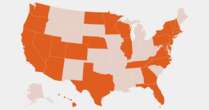Somewhere between 25% and 35% of working Americans are gig workers–either as a supplement to their primary income or as their full-time job. And for many gig economy workers, cash apps and marketplaces offer a simple and convenient way to receive payments. Enter the IRS form 1099-K.
Third-party payment apps have to issue a 1099-K form to taxpayers who make more than a certain earnings threshold—a threshold which the IRS significantly lowered for the 2024 tax year. The IRS anticipates that millions of Americans will receive a 1099-K form for the first time this year because of that reduced earnings threshold.
If you’ve been wondering why you received a 1099-K form this year, here’s what you need to know.
1099-K history
Prior to the introduction of third-party payment apps and online marketplaces, the IRS typically received reporting about your income from either a W-2 form (for traditional employees) or 1099-MISC form (for contractors, freelancers, or other nonstandard employment).
The introduction of third-party payment apps like PayPal changed the landscape for taxable income. Even though freelancers who collect payments via third-party apps must claim every penny of income (just as employees must track and claim their tips), taxpayers seriously underreported their income from third-party payment apps when the technology was new. Uncle Sam estimates that taxpayers underreported $450 billion in 2006, which equated to a 17% noncompliance rate.
Recognizing that modern problems require modern solutions (or at least a new tax form), the Housing and Economic Recovery Act of 2008 instituted a requirement that banks and credit card merchants report payments to the IRS via the new form 1099-K. The first 1099-K forms were issued in 2012 for the 2011 tax year.
Who issues 1099-K forms?
There are several different types of organizations, apps, sites, marketplaces, and platforms that may be required to issue a 1099-K form. These may include:
- Auction sites (such as eBay)
- Ridesharing platforms (like Uber or Lyft)
- Crafting marketplaces (such as Etsy)
- Crowdfunding platforms (like Kickstarter)
- Freelance marketplaces (like Fiverr)
- Online marketplaces (such as Craigslist or Facebook Marketplace)
- Peer-to-peer payment platforms (like Venmo, PayPal, or Cash App)
- Ticket exchange sites (such as StubHub or TicketSwap)
If you have earned money through any of these kinds of platforms, you may receive a 1099-K form this year—if you have taken in more than the minimum earning threshold (see below).
The one commonly used app that will not issue 1099-K forms is Zelle. That’s because Zelle directly transfers money from one bank account to another, rather than holding your funds in an account for you, the way PayPal, Venmo, and Cash App do. But just because Zelle will not issue a 1099-K doesn’t mean you’re off the hook for reporting any earned income you receive via Zelle. You will have to report income Zelled to your account on Schedule C of your tax return.
1099-K minimums
Until the 2024 tax year, the 1099-K form was only issued to taxpayers with more than 200 transactions on third-party payment apps who earned $20,000 or more in income. This meant only the individuals who were seriously committed to making a living via gig work received a 1099-K form.
That is now changing. For the 2024 tax year, if you made $5,000 on a payment app, you will receive a 1099-K, no matter how many transactions you cleared. This means hobbyists and side hustlers are much more likely to receive a 1099-K this year—and the likelihood will keep going up. That’s because the minimum income threshold for the 2025 tax year is $2,500, and it will dip to $600 thereafter—and there is no minimum number of transactions to trigger a 1099-K filing.
This means your aunt Esther who has an Etsy storefront that sells five or six risque needlepoint projects per month will be as likely to receive a 1099-K form as a professional eBay seller with thousands of transactions per week.
Fixing 1099-K errors
Not all transactions on third-party financial apps are taxable. When your sister Venmos you $75 to pay for her half of your mother’s birthday gift, that money is not taxable. But if you receive Venmo payments for your side gig as a photographer, that money is taxable. This means anyone who only has a single payment app for personal and professional payments may see errors on their 1099-K form.
To help ensure you’re not charged tax on nontaxable payments from friends and family, the IRS has added a space at the top of the 2024 Schedule 1 form to report any money that was included on your 1099-K in error.
The spot on the Schedule 1 form also allows you to report 1099-K money related to personal items you sold at a loss. For example, if you resold courtside basketball tickets for $5,000 and accepted payment via Venmo, that would trigger a 1099-K form. But if you purchased those tickets for $6,000 and sold them at a loss, the $5,000 you received is not taxable. You can include that $5,000 in the new space on the Schedule 1 form, and you will not owe taxes on it.
The future of 1099-K filing
The IRS wasn’t quite done tinkering with the 1099-K rules when it lowered the earnings threshold and minimum transaction requirement. As of the 2025 tax year, third-party payment apps may request your taxpayer identification number—which for most people is their Social Security number. If a third-party payment platform does not have your valid tax ID number, the platform has to withhold 24% of your payment for taxes.
This is similar to how your taxes may be withheld from a traditional paycheck, but it can come as an unpleasant surprise to aunt Esther when she sells the $100 Kirk/Spock needlepoint to an enthusiast and only receives $76. While the withheld amount can be credited to the tax you owe when you file your taxes, or it may be refunded if you do not owe any taxes, many taxpayers will prefer to simply provide their Social Security number to avoid the withholding altogether.
File responsibly
With more ways to get paid, there are more opportunities to underreport earned income. To combat taxpayer forgetfulness (both genuine and feigned), the IRS introduced the 1099-K form, which requires third-party payment apps to report earnings over a certain dollar amount.
As of the 2024 tax year, anyone earning $5,000 or more via payment apps or platforms will receive a 1099-K form. In 2023 and earlier, only taxpayers who earned over $20,000 and had 200 or more transactions got such a form. The minimum earnings threshold will go down to $2,500 for the 2025 tax year, and to $600 thereafter and there is no minimum transaction requirement.
Getting more tax forms may feel like a crappy reward for all the hard work you have put into your side gig—but the new 1099-K filing requirements will ultimately make it easier for you to correctly file your taxes. And correct tax filing keeps the auditor away.










No comments